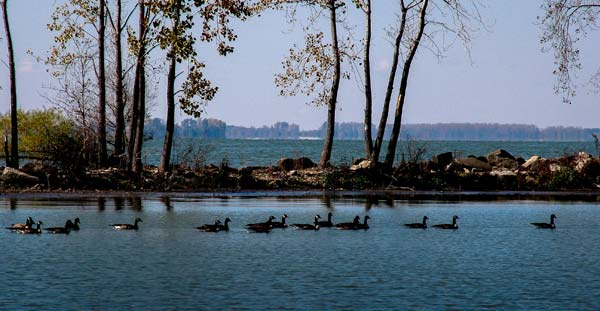
Grand Lake St. Marys: Feeder lake built for the Miami Erie Canal
The feeder lakes... today's great water attractions
Several lakes still remain today as a result of Ohio's canal system. St. Marys, Indian Lake, Lake Loramie, Guilford and Buckeye lakes were all lakes developed as part of the project. These man-made lakes helped feed the canal with water during the dry periods. Between 1825 and 1847, over 33,000 acres of reservoir surface were built to make the Ohio canal system possible.
Unlike natural lakes or reservoir lakes, the feeder lakes are extremely shallow. Although they were located along some stream, they were all built by manual labor and shovels. To overcome to lower volume of water enclosed in the lake, they had to be very large lakes covering many square miles.
Today those lakes are popular vacation spots. However, because of their shallow depth, they are more prone to contamination by local farm fields which means just a little run-off can cause major environmental problems to the lake. Scientists and environmentalists are just now starting to address these issues to help mitigate the effects of farm run-off on the lakes.
-
Buckeye Lake
Construction began in 1826 and completed in 1830. At that time is was called the Licking Summit Reservoir. It didn't become known as Buckeye Lake until 1894 when the Ohio General Assembly established these feeder lakes as state parks. -
Guildford Lake
Guilford Lake was constructed as a canal feeder reservoir for the Sandy and Beaver Canal in 1834. The Sandy and Beaver Canal was one of many feeder canals. The Sandy and Beaver Canal was a feeder to the Ohio and Erie Canal and is located in Columbiana County. -
Grand Lake
In 1837, work commenced on the reservoir for the Miami-Erie canal to maintain the canal’s 4' water depth. Workers using hand tools were paid 35 cents a day and a jigger of whiskey to keep malaria away. At its completion in 1845, 13,500-acre Grand Lake was the largest man-made lake in the world. The lake was connected to the canal by a 3 mile feeder canal. -
Lake Loramie
Lake Loramie was originally constructed in 1844-45 as a storage reservoir for the Miami-Erie Canal system. A short feeder canal connected Lake Loramie with the main canal. Lake Loramie is located south east of Grand Lake St. Marys. -
Indian Lake
Indian Lake was built in 1851 as a feeder lake for the Miami and Erie Canal to maintain the required 4' water depth throughout the canal system

Above: INDIAN LAKE
The Ohio Canal System
After construction had begun on New York's Erie Canal, the idea of building canals in Ohio entered the debate. DeWitt Clinton, the surveyor and driving force behind the Erie Canal also began pushing for an Ohio canal system. Clinton proposed building a canal from the Portage River that flows into Lake Erie at Port Clinton and go south to the Ohio River. It would be called the Sandusky-Scioto Canal.
However, like many things in life, politics and economics put the plan on hold. The Sandusky-Scioto Canal would have gone through Columbus, Chillicothe and connected with the Ohio River at Portsmouth. This idea made a few politicians very happy, but they were in the minority. A canal running down the middle of the state left a large portion of the state not being served. Those politicians made the case that the folks they represented would be paying for the canal, but without receiving any of the benefits. They would be left out of the economic development the canal would certainly bring to those areas it served.
With further study and surveying the engineers decided that there would not be enough water to supply the canal that would have to be built to connect the two main rivers in this route (Portage / Scioto). So a series of compromises were made. Instead of just one canal, serving only a portion of the state, two major canals would be built, with a series of feeder canals so that a much wider area of the state would be served by the new transport system.
This decision made the politicians in both Central Ohio and the Chillicothe area a bit upset. So the decision was made to change the route of the Ohio & Erie Canal, and have it turn west about midway so that it skirted Columbus and then moved on to Chillicothe and Portsmouth. This made everyone happy except the folks in southeastern Ohio, particularly in Marietta.
- Ohio & Erie Canal
- Miami & Erie Canal
- Wabash & Erie Canal
- Warren County Canal
- Cincinnati & Whitewater Canal
- Milan Canal
- Columbus Feeder
- Granville Feeder
- Trenton Feeder
- Hocking Valley Canal
- Walhonding Canal
- Muskingum Improvement
- Sandy & Beaver Canal
- Pennsylvania & Ohio Canal
- Middlebury Branch Canal
- Nimishillen & Sandy Canal
- Sidney Feeder


